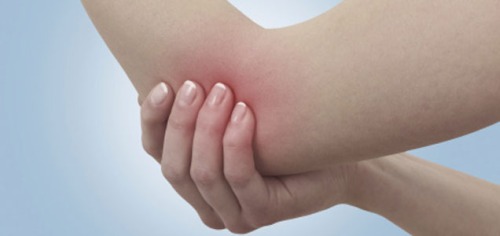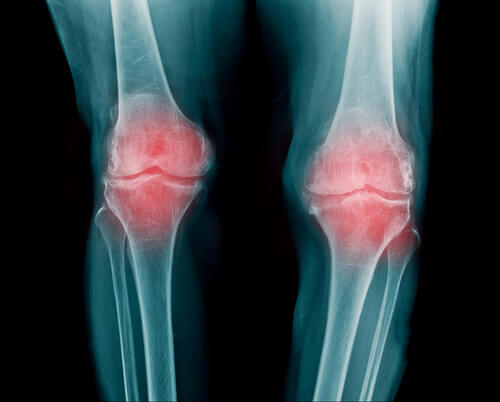Tingling Joints: Causes and Possible Treatments

Tingling joints can be a worrying feeling. Some people often get it when they wake up. Yet, others have it continuously. Sometimes, the tingling doesn’t have to do with the joint going numb due to poor posture. In fact, there are other possible causes.
What are your joints?
A joint is an area where the ends of two or more bones, or bone and cartilage, come together. They allow your body to move. Basically, they let your arms, legs, and back flex and turn.
Between the bones that make up the joint, there is a flexible, elastic tissue: joint cartilage. Cartilage prevents friction between the bones, acting like a buffer or cushion.
The joint is surrounded by a “joint capsule” that supports the whole system. In turn, ligaments that keep your joints from being becoming damages support that system.
Why do I have tingling joints?

Sometimes the symptom comes and goes for no apparent reason. In this case, your body has likely just fixed the problem on its own. But when you have chronic tingling joints for a long time, you should seek medical attention.
Illnesses and health issues that cause tingling joints
The most common include:
Rheumatoid arthritis

- Rheumatoid arthritis is inflammation of the joint. It may affect multiple different joints. Generally, it affects the fingers, arms, and knees.
- It usually starts between 30 and 60 years of age, and it’s more common in women than men. There are no differences in incidence between races nor place of residence.
- People with rheumatoid arthritis have reduced mobility. After the tingling, worse pain begins.
- It happens when calcium deposits accumulate in the joint. Then come the tingling joints and weakened cartilage, which gradually breaks down and causes pain to get worse.
- We see it most often in the wrists, fingers, and knees. However, it may affect other joints as well. This illness is related to osteoarthritis and thyroid disorders.
- It’s painful, but it does not destroy the joint.
We think you’ll like:
Osteomyelitis
Osteomyelitis is an infection of the bone caused by bacteria or a fungus. The germs reach the bones through your blood stream and if they find a home in your joint, they damage it.
The first symptom is tingling joints, but later the pain intensifies. You can treat osteomyelitis with antibiotics and it affects both children and adults.
Lupus
- Lupus is an autoimmune disease. The immune system, instead of doing its job of protecting your body, attacks healthy tissue. It can damage different parts of your body.
- Tingling joints is one sign that lupus is affecting your bones or cartilage.
- There is no cure per se, but you can keep it under control.
Check out:
Tips for preventing joint problems

Diet is important. Certain foods can give your body the nutrients it needs to prevent joint pain and the illnesses and disorders that cause it.
- Omega 3 is very effective, since it reduces inflammation and slows down the breakdown of joint cartilage. Oily fish and flax seed are both high in omega 3. You can also take it in supplement form.
- Celery is diuretic and contains antioxidants. It’s advisable if you want to detox and remineralize your body. It is a must-have in your diet, in salads, smoothies, or teas.
- Nettle is detoxifying and has the ability to help with the symptoms of arthritis. You can eat it or apply it to the joint in a mixture of crushed herbs in alcohol.
- Ginger is a potent anti-inflammatory and pain-reliever. You can have it in tea form or add grated ginger to other food.
Eating a healthy diet is always helpful in preventing illness. However, remember that only doctors can diagnose the cause of tingling joints. Thus, we recommend seeing a doctor if your symptoms persist.
All cited sources were thoroughly reviewed by our team to ensure their quality, reliability, currency, and validity. The bibliography of this article was considered reliable and of academic or scientific accuracy.
- Simopoulos, A. P. (2008). The Importance of the Omega-6/Omega-3 Fatty Acid Ratio in Cardiovascular Disease and Other Chronic Diseases. Experimental Biology and Medicine. https://doi.org/10.3181/0711-MR-311
- Ginger. (2010). In Botanical Medicine for Women’s Health. https://doi.org/10.1111/ijfs.12940
- Altman, R. D., & Marcussen, K. C. (2001). Effects of a ginger extract on knee pain in patients with osteoarthritis. Arthritis and Rheumatism. https://doi.org/10.1002/1529-0131(200111)44:11<2531::AID-ART433>3.0.CO;2-J
This text is provided for informational purposes only and does not replace consultation with a professional. If in doubt, consult your specialist.








